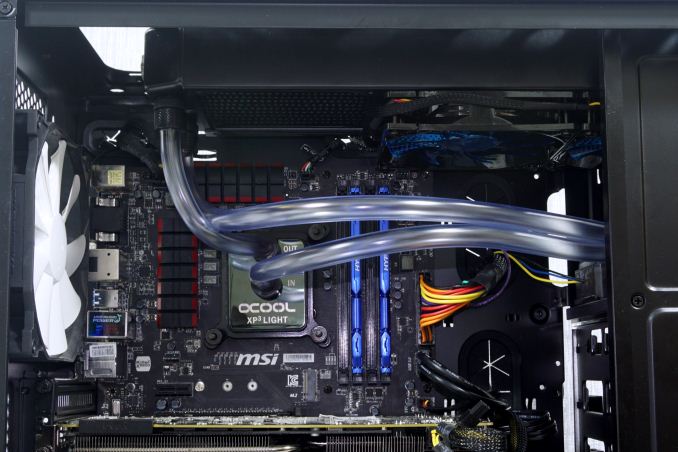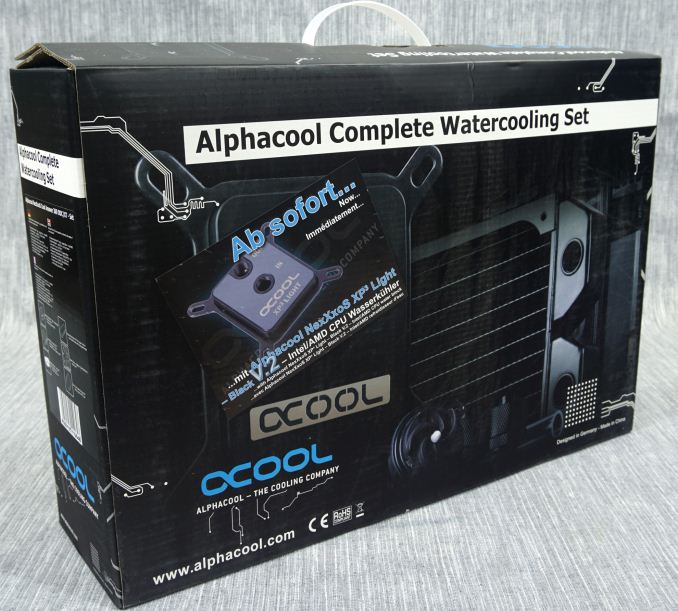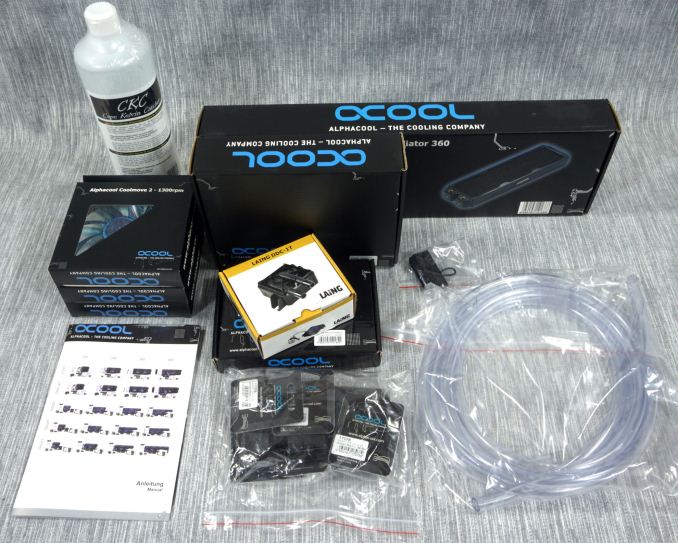The Alphacool NexXxoS Cool Answer 360 DDC/XT Liquid Cooling Kit Review
by E. Fylladitakis on October 24, 2016 9:30 AM EST
Not so long ago, PC liquid cooling was considered to be an extreme approach, one performed by hardcore enthusiasts and overclockers alone. There were no commercial products available and every individual system was designed by the user. Radiators were modified heater cores extracted from cars, CPU blocks were rare and occasionally machined at local workshops using a copper block and a mill, while high-performance tubing came from shops with medical supplies.
As demand grew, aided by the ever-increasing noise of small CPU heatsinks, companies specializing in these "open loop" liquid cooling solutions began turning up -- a little too fast perhaps, as tens of companies were founded within a few months' time and very few of them actually survived for more than a couple of years. Enthusiasts could then buy specialized liquid cooling equipment and even whole kits from just one seller and only had to assemble the setup into their system. That of course is no simple process for an amateur and a nightmare for a system builder, who had to find ways to ship systems pre-filled with coolant or assume that the user has the skills required to fill & maintain such a system. The payoff in terms of cooling was often immense, but the potential market remained limited to advanced users only.
Liquid coolers finally achieved adoption with the wider enthusiast use base at the start of this decade, when the likes of Asetek and CoolIT Systems came up with an inexpensive closed loop solutions, a design was just as simple to install as a common air cooler and required virtually no maintenance at all. However, as convenient as these all-in-one (AIO) solutions may be, hardcore enthusiasts find them lacking and inflexible. Some of the compact AIO designs can hardly compete against air-based solutions in terms of performance. A few companies began making their systems expandable, but the main parts of the system still cannot be upgraded. As such, AIO coolers rarely are acceptable solutions for the most hardcore of enthusiasts and overclockers, who need the best performance and still prefer designing and building their own liquid cooling systems.
Alphacool is a German designer and manufacturer of liquid cooling systems for PCs who has also diversified into producing liquid cooling systems for industrial and medical applications. They are one of the oldest companies in the field and, even though we did have a review of their recent Eisbaer AIO solutions, their specialization lies with the design, manufacturing and supply of high performance liquid cooling parts for advanced PCs.
Except from individual parts, Alphacool also supplies their products as complete pre-tested kits. It is one of these kits that we will be reviewing today, the NexXxoS Cool Answer 360 DDC/XT. The kit includes:
- 1x Alphacool NexXxoS XP3 Light Cooling Block
- 1x Alphacool Repack 5,25 Bay Reservoir
- 1x Laing 12V DDC-1T Pump
- 1x Alphacool NexXxoS XT45 Full Copper Radiator
- 3 meters AlphaTube tubing HF 13/10 (3/8“ID) - clear
- 6x Alphacool HF 13/10 Compression Fittings G1/4
- 3x 120 mm Alphacool Coolmove Fans
- 1x Alphacool CKC Cape Kelvin Catcher Liquid 1000ml
- 1x ATX-bridging plug (24 Pin) - black
Packaging & Bundle
Alphacool supplies the NexXxoS Cool Answer 360 DDC/XT kit in a large, very sturdy cardboard box. The artwork is simple, based on pictures of the included parts and basic information about the kit.
Every included part is packed in its own cardboard box, meaning that the exterior box only provides shipping convenience and protection. The packaging of the individual parts, with the exception of the liquid pump, bears the Alphacool company logo. The clear PVC tubing does not have its own packaging, though that would be redundant as it is nearly impossible to damage such an item during transport. Alphacool also supplies a thorough manual.












40 Comments
View All Comments
Death666Angel - Tuesday, October 25, 2016 - link
That works for people hard of hearing, those willing to put up with abysmall thermals and/or loud noise or those like you who have enough space and willingness to put the source of the noise in another part of their dwelling.BrokenCrayons - Tuesday, October 25, 2016 - link
That's a lot of exaggeration. Stock coolers are ear-splitting monsters that let the chip run at unsafe temperatures. There are literally billions of PCs that have been shipped with OEM coolers over the years and while a few designs have been fatally flawed (I'm looking at you ECS GREEN320 laptop with your whiny hair dryer blower on a 1GHz VIA C3 processor) the vast majority of them provide years of problem-free service by keeping the CPU within manufacturer specified temperature limits without causing undue end user stress due to poor acoustic design.Keep it in perspective. I'd happily agree that temperatures might be lower and the computer might be quieter with a bit of attention paid to cooling, but the way you're putting things seems overly dramatic.
HollyDOL - Monday, October 24, 2016 - link
I moved to custom loop to get rid of "angry vacuum cleaner" (back in 8800GT days). My pump is sitting in a foam inside the case and radiator is external, passive and quite big. In combination with noise dampening case and semi-passive PSU it's silent at city night (I guess in significantly quieter environment you could hear a bit but not really much).galta - Monday, October 24, 2016 - link
Liquid cooling is for people for want/need extreme performance, generating tons of heat in the process. Heatsinks that come out of the box cannot handle it.There is also the question of noise, for cooling an OCed system on air produces - generally - more noise than on liquid.
Those, however, do not seem to be circumstances that apply to you, so you better stay on air.
JoeyJoJo123 - Monday, October 24, 2016 - link
I'd clarify the "generally" part as follows:If they're using an AIO, chances are the combined pump + fan noise is actually noisier than a dual stack tower heatsink. (2x 120mm or 140mm fan + pump noise VS 2x 120mm or 140mm fans and no pump).
If they've built a custom open loop, then chances are that they've over-engineered the solution (as the few who go this route have the cash to spend and are willing to go all the way) and are using a thick radiator, a large reservoir, a large but quiet pump, and fans that don't ever need to spin up to address increased heat on intensive tasks, and at this point, they might actually have a quieter solution.
galta - Monday, October 24, 2016 - link
Lots of chances involved, it seems. In the end, what makes sense - generally - is to understand your problem and look for the best way to solve it.For some, air will do; for others, not.
Check Corsair's H110iGT review @ Guru3d: it is as quiet as the venerable Noctua NHD15, but 9C cooler when overclocking an i7 4790k. Oh, and it also significantly lighter than 1.32kg.
But then there is our friend BrokenCrayons, mixing bunnies with pancakes...
fanofanand - Tuesday, October 25, 2016 - link
I thought his points were valid and reasonable, far from mixing bunnies with pancakes.BrokenCrayons - Monday, October 24, 2016 - link
To steal a certain internet meme, "Overclocking in 2016 makes about as much sense as a bunny with a pancake on its head."Aerodrifting - Monday, October 24, 2016 - link
What's the point of running X99 i7 if you don't overclock? So you can be content with stock 3.0 speed?BrokenCrayons - Tuesday, October 25, 2016 - link
What's the poinnt of overclocking it? The home user's typical workloads don't benefit from overclocking and if they do, the increase in performance is marginal and not worth the effort. Sure there's showboating to friends and emotional self-gratification, but those aren't tangible rewards. If emotional satisfaction is what you gain from that sort of thing, then knock yourself out, but in my opinion, it's wasteful, childish, and silly.